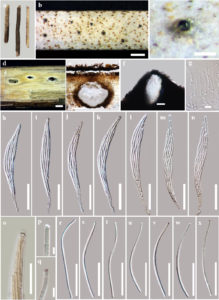Neolinocarpon arengae Konta & K.D. Hyde, in Konta, Hongsanan, Liu, Eungwanichayapant, Jeewon, Hyde, Maharachchikumbura & Boonmee, Mycosphere 8(10): 1968 (2017)
Index Fungorum number: IF 553963; Facesoffungi number: FoF 03847
Etymology – The specific epithet refers to the host genus Arenga
Holotype – MFLU 15–0298
Saprobic on dead leaflet of Arenga pinnata (Wurmb) Merr. Sexual morph Ascomata 336–566 μm high × 230–490 μm diameter (x̅ = 430 × 368 μm, n = 10), solitary, deeply immersed, with a central raised black, papilla, with a central ostiole. Papilla 129–218 μm high × 174–296 μm diameter at the base (x̅ = 154 × 203 μm, n = 5), black, shiny, with hyaline periphyses. Peridium 33–80 μm diameter (x̅ = 50 μm, n = 10), outer cells merging with the host epidermal cells, composed of dark brown to black cells of textura angularis. Hamathecium comprising numerous, 2–4 μm diameter (x̅ = 3 μm, n = 10), hypha-like, septate, unbranched paraphyses, longer than asci. Asci 168–214 × 15–21 μm (x̅ = 186 × 18 μm, n = 20), 8-spored, unitunicate, cylindrical, long pedicellate, with a J-, wedge-shaped, subapical ring. Ascospores 114–134 × 3–4 μm (x̅ = 121 × 4 μm, n = 20), parallel when immature, becoming spiral at maturity, filiform, straight or curved, hyaline, aseptate, containing numerous refringent septum-like bands, ends rounded, with polar mucilaginous appendage at apex, smooth-walled. Asexual morph Undetermined.
Culture characters – Ascospores germinating on MEA within 2 days. Colonies on MEA reaching 6–8 cm diameter after 2 months at 25°C, white to gray at the edge, gray to brown in the middle forward until nearly margin, light brown at margin, dark brown when mycelium growing into media 30 days of incubation, colonies smooth, flat, lobate margin, hyphae septate, branched, smooth.
Material examined – THAILAND, Phang-Nga Province, on dead leaflet of Arenga pinnata (Wurmb) Merr. (Arecaceae), 5 December 2014, Sirinapa Konta PHR07d (MFLU 15–0298, holotype); HKAS100703, isotype; ex-type living culture, MFLUCC 15–0323.
GenBank Accession numbers – SSU: MG366597; RPB2: MG272261.
Notes – Neolinocarpon arengae is similar to species of Neolinocarpon with respect to the ascomata and filiform ascospores. It, however, differs from some species in terms of ascomata size, ascospores shape at both ends and presence of mucilaginous appendage, and based on host differences. Phylogenetic analysis indicated that Neolinocarpon arengae is related to N. rachidis (96% ML, 1.00 PP) (Fig.1).

Fig 1. Neolinocarpon arengae (MFLU 15–0298, holotype). a Appearance of ascomata on host substrate. b, c Close up of ascomata. d Yellowish ascospore mass. e Section of ascoma. f Papilla. g Paraphyses. h–n Asci. o J- reaction of apical ring. p–q Appendages. r–x Ascospores. Scale bars: b = 500 μm, c = 200 μm, d = 50 μm, e = 200 μm, g = 10 μm, h–n, r–x = 50 μm, o = 20 μm, and p–q = 5 μm.
